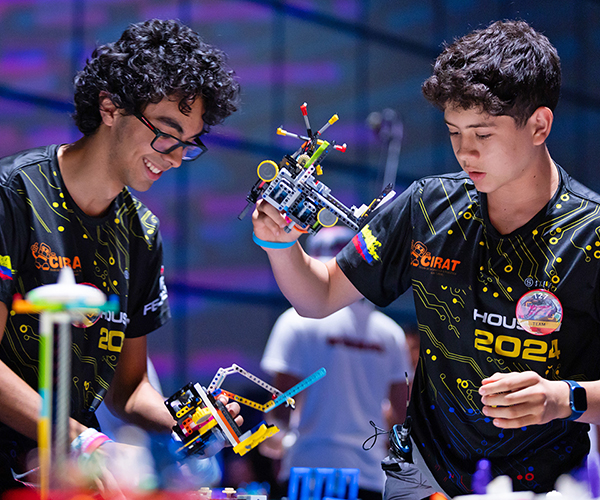| View the child-care center chart, which features costs, amenities and more. Click here. |
With peals of laughter, she tears down the LEGO tower she's just built, then scans the room for a new target. She zeros in on another girl's creation: a 2-foot-tall LEGO dragon named Mushu that has been left unattended for a moment. Tori scurries over just as the girl returns.
"No!" she wails. "Not my dragon!"
"She's not going to take it apart," says Miss Janet, looking directly at Tori, whose hands indeed are poised to take it apart. "She just wants to look at it.
"Right, Tori?" Miss Janet coaxes. "Right, Tori?"
The pigtailed Tori, who turned 2 in October, removes her hands from the dragon. Mushu is saved. No tears are shed, no tantrums thrown.
That's about as wild as things got for Tori — or for any toddler — one December day at the Oberlin Early Childhood Center, regarded by many as a model child-care center. Its teacher-child ratios are low (1:3 in the infant room, for example; much better than the state-mandated 1:5). Its teachers are well trained (most have associate's degrees or special training in child development). The facility is open and airy with a huge outdoor play area. And — most shocking of all — it's affordable to everyone. The families of the lowest-income children here pay $4 a month. The highest-income families pay no more than $663.
Those features add up to the type of child-care center of which most working parents only dream.
After putting the LEGOs away, Miss Saless asks the children to form a line, a seemingly impossible request for any group of 2-year-olds. But the children quickly scamper into place.
"What are we going to do?" asks Miss Janet. "Are we going to run or are we going to walk?"
"Walk," the children say in unison, nodding their heads.
"I mean run," squeals Tori.
Miss Janet gently corrects her and the group heads into the "muscle room," a large play area with vaulted wood ceilings where the children burn off energy when it's too cold to go outside. For Tori, that means leading two other girls in a cat crawl across the room, riding a tricycle and being toted around in the back of a toy tractor. On nicer days, there are 3 1/2 acres of fun behind the center: a miniature village complete with three houses, a covered bridge and a walking trail. In the summer, the children tend gardens.
When the half-hour play period ends, the children quietly return to their room, where paint and paper is already set out for them at two wooden tables. They create blue-and-red renderings of superheroes, cars, their parents and grandparents. Tori paints her daddy.
"I got purple!" yells one girl, after mixing just the right amounts of red and blue. With an art coordinator on staff, the discovery probably isn't an accident. These 2-year-olds are in the process of learning color theory, as evidenced by cheery diagrams on the walls.
When they're finished painting, the children line up quietly to wash their brushes and their hands in two child-sized sinks. Tori asks for toothpaste and is reminded that she's washing her brush, not her teeth, which the children do after both breakfast and lunch here. Smiling so wide that her nose crinkles, Tori hits the wall dispenser twice, then rubs her hands in the soap on the countertop. She is applauded, not disciplined, for this unique lathering technique. (She's also known for flushing as many times as she can after using the potty.)
Lunch today, served family style, is chicken wings, mixed vegetables, fruit and milk. It's prepared onsite in a full-scale kitchen next to a miniature version where the children bake muffins and cookies. Prepackaged foods are not served here.
While 2-year-olds generally are considered the rabble-rousers of child-care centers because of their biting, crying and fighting, none of that goes on here today. The children follow orders without any teacher having to raise her voice. While the children have fun playing, they don't get overexcited or out of control. The scene doesn't fit the stereotype of a child-care center. It appears to be nothing more than a group of little children having a good time.
So how does Oberlin Early Childhood do it?
"It looks easy when it's there; it just flows, but it takes a lot of planning and attention for teachers to create that atmosphere," says executive director Nancy Sabath. "It's the teachers that make the difference." The annual job turnover rate at child-care centers ranges from 25 percent to 40 percent, according to the Center for the Child Care Workforce. Here, it was 4 percent last year (one teacher who left after her husband was transferred out of town). Miss Saless Maxwell and Miss Janet Gregory have been at the center for nine and three years, respectively.
With that kind of continuity, the culture of the center becomes embedded in its teachers. A phrase that Sabath uses often is "respect for children." Practically speaking, that means serving them wholesome food, planning activities ahead of time and disciplining in a constant way that eliminates the need for shouting. Each room has weekly planning meetings. A child therapist consults with the staff once a week.
Above all, to respect children at this center means to love them, which Sabath says she values more in applicants than degrees and credentials, though those are abundant here as well. (Sabath herself holds a master's degree in early childhood education.) Not once that day were Miss Janet or Miss Saless observed sitting on a chair or standing away from the children. During LEGO time, they talked on LEGO "phones" to one child's grandparents ("Oh yes, she's a good girl."), examined a family of mice living inside a clear LEGO the size of a dime ("Oh yes, I see them.") and promised to visit a LEGO airport for a trip as soon as construction was finished. Children frequently climb up on laps for hugs.
In addition to dedicated teachers (who are paid an average of $18,000 a year), the second reason for the center's success is the $250,000 in grant money it receives each year. Founded as a summer camp in 1968, the nonprofit center expanded in 1973 with help from Evan and Cindy Nord of the Nord Family Foundation.
There are currently 105 children at the center, who range in age from 3 months to 5 years, plus about 20 after-school children. Forty percent come from low-income homes. Many of the rest are the children of Oberlin College professors. Each family pays what it can afford. Sabath estimates that it costs about $9,000 a year, or $750 a month per child, to run the center. Most of the families don't pay anywhere close to that amount.
"What we have here should be for all children," Sabath urges.
In order for that to happen, she says there would have to be a higher reimbursement rate from the Ohio Department of Jobs & Family Services, tiering so that higher-quality centers receive larger reimbursements. There also should be private-corporate partnerships to support families with child-care costs.
In 2000, the Oberlin Center won an award for excellence from the Ohio Department of Education. Directors from other child-care centers frequently observe and take notes on the operation.
None of this means anything to Tori, of course. While she's here, she likes to sing her favorite song, "Take Me Out to the Ball Game," and count to 10. She can pedal a tricycle clear across the muscle room at top speed and work a batch of Play-Doh into any number of creatures.
But Tori doesn't know she's learning. She just thinks she's having fun. And that's the way it should be.



